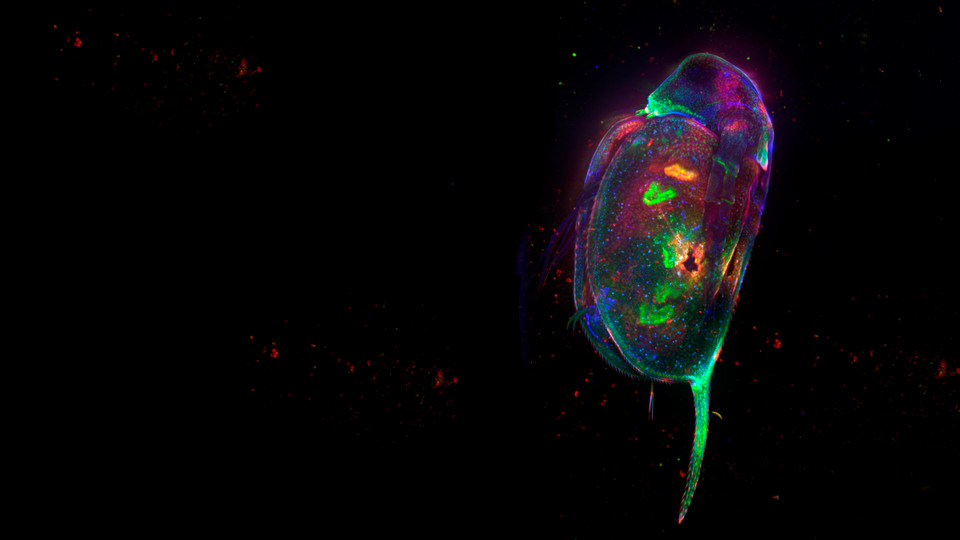
Staining of daphnia magna is used for more rapid assessment of hazard properties
High-content screening and high-content analysis can be used for more rapid assessment of hazard properties and better prediction of ecotoxicological effects in aquatic species such as daphnia magna. This is the focus of two collaborating research groups in Mistra SafeChem.
The research groups of Oskar Karlsson and Magnus Breitholtz at Stockholm University collaborate closely within Mistra SafeChem. The team is centered around PhD students Cedric Abele and Amira Perez who conduct most of the experimental work.
Development of new approach methodologies
Oskar Karlsson has a research group at SciLifeLab that supports Mistra SafeChem in mechanistic toxicology. His team combines experimental model systems, computational toxicology, omics tools, and epidemiological research to determine the influence of the exposome, including endocrine disrupting chemicals, pesticides, metals, and particulate air pollution, on wildlife and human health.
– This work includes the development of new approach methodologies (NAMs) that can provide fast information for chemical hazard and risk assessment, Oskar Karlsson says.
More focused on ecotoxicology
Magnus Breitholtz’s group is more focused on ecotoxicology and improving risk assessment of environmental contaminants.
– The main goal is to seek more relevant and sensitive test methods and biomarkers, as well as linking effects at the laboratory scale to the situation in the field to better predict or describe contaminant effects in the environment, Magnus Breitholtz explains.
This work is primarily conducted with zooplankton, including copepods and daphnids, and aims to establish links between different levels of biological organization and to develop novel ecotoxicological tests and approaches.
Multiplexed staining protocols for rapid assessment
Their common goal in the Mistra SafeChem programme is to use high-content screening and high-content analysis (HCS/HCA) and develop multiplexed staining protocols for a more rapid assessment of hazard properties and better prediction of adverse ecotoxicological effects in aquatic keystone species such as Daphnia magna.
– This is important as current ecotoxicological testing strategies are both too slow and insensitive, failing to sufficiently protect biodiversity on our planet with rapidly increasing amounts and diversity of manmade chemicals, Oskar Karlsson says.
– Our automated fluorescence imaging protocols demonstrate the potential of image-based methods for mechanistic toxicology studies in a large number of Daphnia magna individuals, Magnus Breitholtz adds.
– We are also investigating the effects of chemicals, as single compounds or as mixtures, in cell models. This includes the development of fit-for-purpose staining protocols that combine several antibodies or stains that can be used to answer specific toxicological questions, Oskar Karlsson explains.
New approach methodologies are central
The European Commission has established Safe and Sustainable by Design (SSbD) chemicals and materials as the central prevention approach within the Chemicals Strategy for Sustainability. Here Mistra SafeChem can play an important role by for example contributing to the development of a toolbox that can be used to evaluate functionality, chemical safety, and environmental sustainability.
– Development of NAMs that our team specifically is working on will be central to provide rapid high-quality data for chemical hazard and risk assessment, early in the SSbD process, Oskar Karlsson says.
Pleased to stimulate development of PhD students
– We both see the vital importance of educating the next generation of researchers that will drive the global transdisciplinary collaborations needed for a successful transformation to a safe, sustainable world.
– We are therefore particularly pleased to be part of stimulating the personal and professional development of PhD students during their thesis work. Catalyzing creative and critical independent thinking can help to identify and solve major environmental challenges, in ways we have not thought about ourselves.
Read more about the work
The developed HCS/HCA protocols for toxicological studies in Daphnia magna are in the process of getting published.
So far, the group has published two papers within the Mistra SafeChem programme:
Read more about the latter study in this Mistra SafeChem news article:
A mixture of PFOS and PFOA is more harmful than each chemical on its own External link.
External link.
-
2024-04-03 | newsFour more years – Mistra SafeChem gets go-ahead for second phase
-
2024-03-28 | newsThe 2023 Mistra SafeChem annual report focuses on more than just one year
-
2024-03-21 | newsSETAC conference on LCA will be held in Gothenburg
-
2024-02-27 | newsMistra SafeChem researchers keynote speakers at large conference on SSbD
-
2024-02-16 | newsThe Mistra SafeChem cosmetics study specially invited to EU workshop on SSbD

